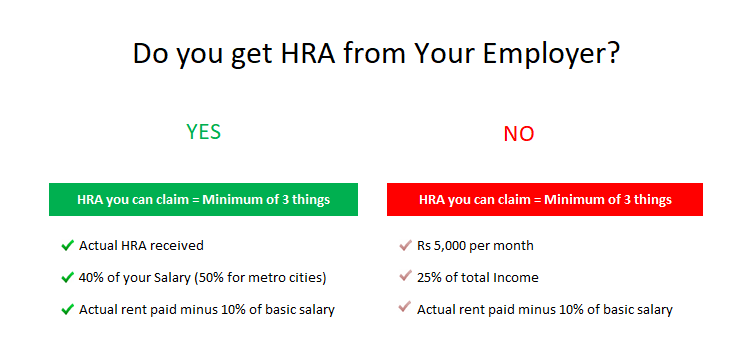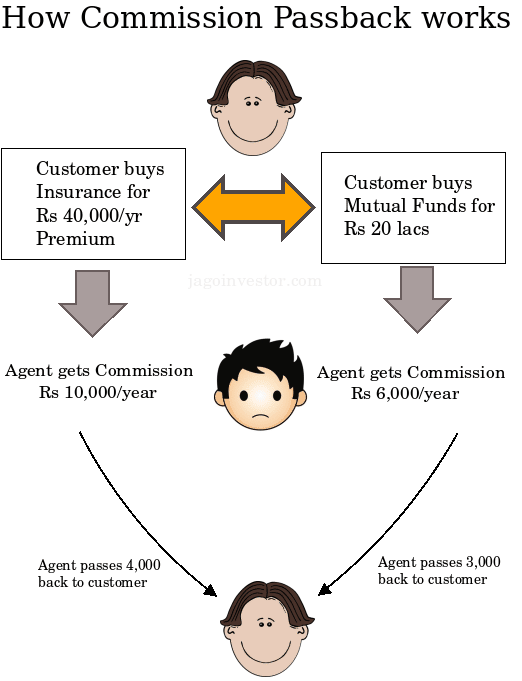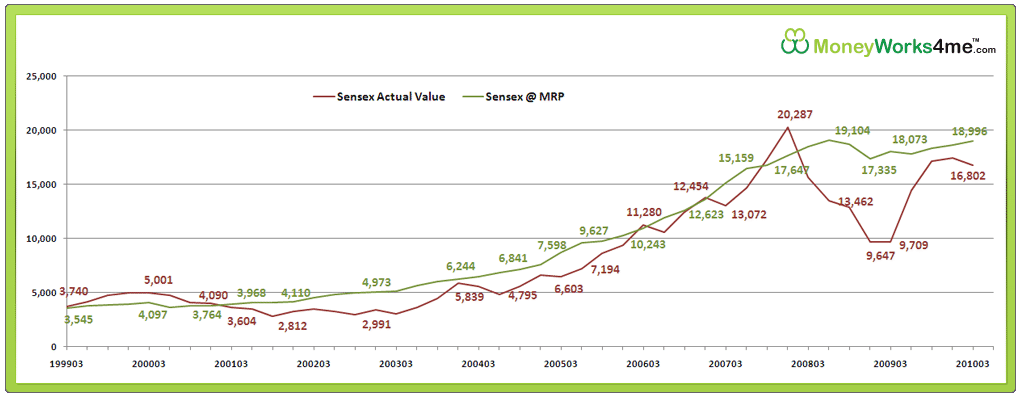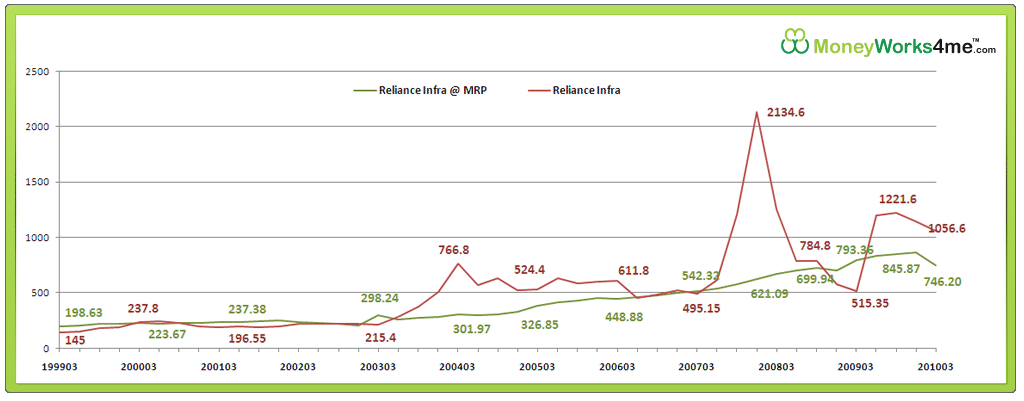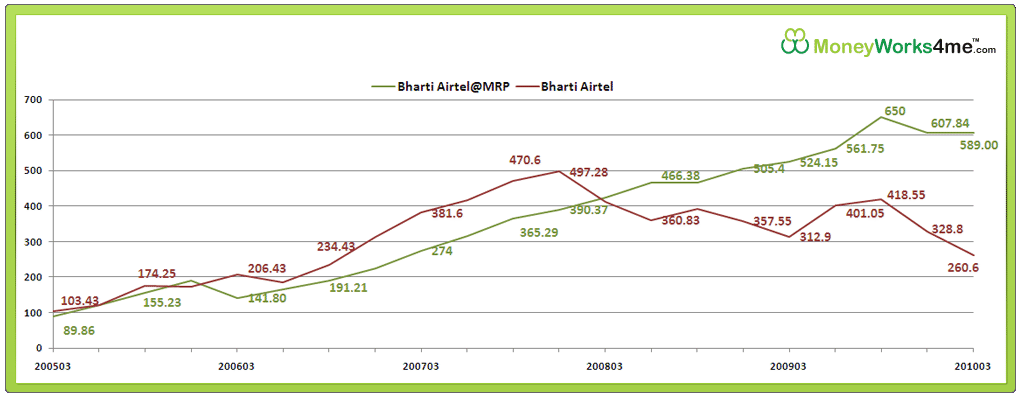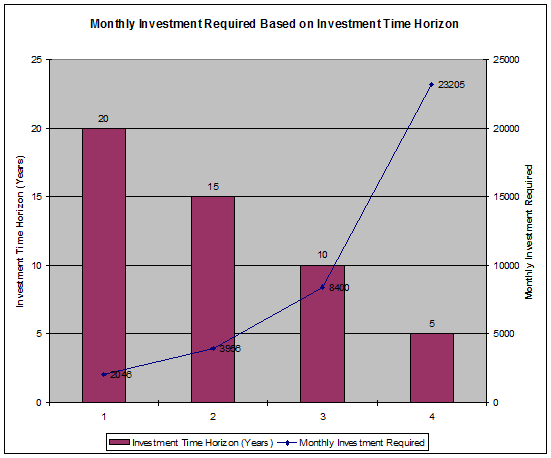Monthly Income Plans– When you hear it for the first time, you get a feeling that it’s some kind of assured and non-risky product that will deliver you uninterrupted monthly income, but it’s not exactly that way. Do you have a lot of cash which you want to park somewhere with the expectation of better returns than a Fixed Deposit? Are you looking for some kind of instrument that will give you regular income with decent returns with moderate or low risk? If yes, welcome to the world of Monthly Income Plans, which are also known as MIP’s.

What are Monthly Income Plans?
An MIP is nothing, but a debt-oriented mutual fund that gives you income, in the form of dividends – simple as that. As MIPs are debt oriented mutual funds, they invest heavily in debt instruments like debentures, corporate bonds, government securities, etc. It generally has 75-80% of its money in debt and rests in equity and cash. The income you can get from MIP is not limited to the monthly option. You can also choose to receive income quarterly, half-yearly or annually. Just like any other mutual fund, the MIP too comes with two options.
1. MIP with Dividend option: MIP’s with dividend option provides you an income in the form of dividends. There is an option to receive this income monthly, quarterly, half-yearly and yearly. So you have to choose the option at the time of buying the MIP. Note that while the dividend from MIPs is tax-free in the hands of investors, the company has to pay a dividend distribution tax of around 14% on the dividend before it reaches your hand. So your returns reduce by that much.
For example, If a company declares a dividend of Rs 3 per unit, they have to pay 42 paise (14%) as a Dividend Distribution Tax and you will only get the remaining amount in your hand , on which you don’t have to pay any tax. I hope you know, that the NAV of your MIP will come down by Rs 3 after the dividend is declared and given to you. So don’t shout your excitement to all the world when you get dividends, it’s just your own money which you got!
2. MIP with Growth Option: Here, the money is not paid out to you in forms of dividends, instead it keeps growing in the mutual funds. Hence your money is just growing inside the fund itself and you can reap all the benefits at the time of redeeming the funds in the future. In this option, you have nothing to do with dividends. Note that you get the power of compounding in growth options because your returns also earn in the future. Here is an article on the difference between dividend vs growth option in mutual funds to give you a better idea of what I am talking about.
Features of Monthly Income Plans
1. Dividends can be declared only from the profits and not from Capital
Regulations demand that dividends can be paid only from surpluses and not from capital investment. What it actually means is that dividends can be declared from earned income only. If your initial NAV was Rs 10 and after a month the NAV rose to Rs 10.2, The dividend can only be given out of this 0.2 and not from the initial capital value. This makes sure that Company can not show to the world that they are constantly giving income in case they have not done well.
2. No guarantee of Regular Income
The biggest myth about Monthly income plans is that they provide guaranteed monthly income, which is not true (See this question asked by Krishna on our Forum). While the aim of MIPs is to regularly declare dividends, it might happen at times, that they do not declare any dividends because of bad performance. To top that, there is no regulation or oversight on the MIP’s part to declare regular dividends. So take it on the chin, if you don’t get your income once in a while.
3. MIP’s return is influenced by interest rates and stock market
Just because it’s a debt oriented product, It does not mean that they are “safe” . Even MIPs can give a negative return, but in extreme cases. The debt portion is influenced by interest rates. When the interest rate falls, the NAV rises as the price of bond increases. When the interest rate rises, NAV falls. At such times the equity portion of the fund helps to maintain the return. Here is an article on Interest Rates and how they affect Mutual funds.
4. MIPs are prone to mis-selling because of a high commission structure
MIPs offer lucrative commissions to agents as much as 1-1.5% unlike 0.5-.75% in Equity funds. Due to this, it becomes easy to missell MIP’s as they can be labeled as “Safe Funds” and “Monthly Income Plans” which Indians like to hear a lot.
“Look what happened after the abolition of entry load in mutual funds in 2009 . From the last 1 Year, the corpus of MIP schemes have seen a huge inflow all over India. Last year, the total industry AUM was close to Rs. 3700 crore and today it is well over 24500 crore. In this entire period, equity funds AUM have gone down. Now when the intentions itself are not good, needless to say that the outcome will be right. Many investors are not aware that there is an EXIT Load of 1% in almost all MIPs if you were to withdraw before one year & in some cases even 1.5 years.” – says Hemant Beniwal on this Forum post
Taxation of MIP’s
MIP’s are debt funds and hence the taxation is same as debt funds .
Short Term Capital Gains: Any profit before a year would be Short term capital gains and it would be added to your income and taxed at your slab rate. So for investors who are in higher tax slabs it would be wise not to sell their MIP’s (in case they can) before a year, else there will be a good amount of tax on your profits.
Long Term Capital Gains : Any profit you get after 1 yr in MIP would be taxed at 10 per cent without indexation or 20 percent with indexation, whichever is lower.
Short Term and Long term Capital Loss : The best thing about MIP’s over FD’s or Post office schemes is that incase you have any loss in MIP’s , you can set it off against the capital gains in the same year or in next 8 yrs , which makes sure that even losses can be used for tax saving purpose.
Dividends : All the dividends received from the MIP’s would be tax-free in the hands of investors, but note that companies already pay Dividend distribution tax from the MIP’s
Read more on Short term and long term capital gains
MIP’s save money for bad times
Think about ants! They make sure that they save enough food for the rainy season, so that they don’t fast in bad times. In the same way MIPs do not declare all the earned income as dividends, instead they declare a part of earned income as a dividend and save rest for troubled times in future.
This makes sure that when there are bad days in future and MIPs do not see much growth, they can use the money saved, to declare dividends. For instance, in 2008, despite bad markets, 19 funds skipped only up to four monthly dividends.
However, a lot of MIP’s didn’t perform that well and could not save the part of earned income in a proper way. Hence they had to skip all 12 months dividends. Eg., Canara Robeco MIP Mn Div, which skipped all 12 dividends in 2008 and 9 months dividends in the year 2009. See the chart on the right to get more insight into how MIPS missed their dividends. Source: LiveMint
Beware: There is one more option called dividend reinvestment in MIP’s apart from Dividend payout and growth . If the payable dividend is less than Rs 250, then the dividend would be compulsorily reinvested.
Who should Invest in MIP’s ?
1. Investors looking for regular Income
If you are retired/semi-retired or just looking to generate some regular income can look at MIP’s as an option. Note that instead of choosing a monthly option of income, I would rather suggest a quarterly or half-yearly option .
2. Conservative investors looking for better returns
Are you a conservative investor but still looking for better returns than pure debt options like Fixed deposits or Insurance policies? Well, you can’t get 100% safety with MIP’s, but there are very good chances that you would be getting better than FD returns with MIPs.
3. Investors who want to park a big sum of money
A lot of people have questions like “Where to park my lump sum money for medium-term with lower risk ?” If your horizon is very less – like 6 months or a year, MIP’s might not be the best option, but if you want to park it for 2-3 yrs with low risk, MIPs with growth option can be a suitable instrument .
MIP vs Fixed Deposits/ Fixed Maturity Plans/ POIMS
You might get confused between so many debt products and might be wondering how Monthly Income Plans compare to Fixed Deposits (read this post by Deepak Shenoy) , Post Office Monthly Income Scheme or Fixed Maturity Plans (FMP) . There are various parameters on which they all differ . Below is the chart which shows you those differences .
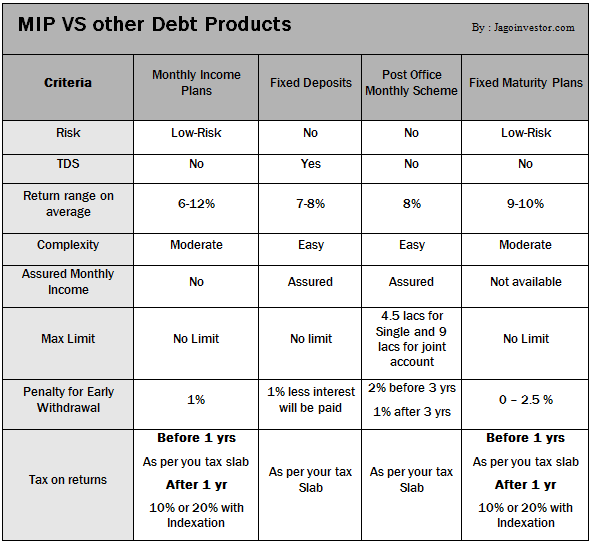
Two ways of getting income from an MIP
We will see two different ways of generating monthly/quarterly income through MIP’s Monthly. One is the regular way of choosing a dividend option and the options one is starting a Systematic Withdrawal Plan from MIP after a year of buying it. Let’s look at both and its pros and cons …
1. Choose dividend option
The good point in this option is that you will start getting the income immediately as the company starts declaring the dividends, and you don’t have to take care of taxation issues. However, the bad side is that eventually 14% dividend distribution tax would be paid by the company and the stability of income will depend on how often dividends are declared by the company. If they skip the dividend you will not be getting the income for that month/quarter.
2. Choosing growth option and start SWP (Systematic Withdrawal Plan)
If you use a bit of strategy, you can create a more stable and more tax efficient income by this method. You can choose growth option in MIP and after 1 yr you can start a SWP (systematic withdrawal plan , opposite of SIP) from your MIP to your bank account . What will happen with this option is that you will not have to depend on companies dividend announcement , as it’s your decision to liquidate a fixed part of your MIP’s, sell it and get the money in you bank account . Also as you are doing it after 1 yr, there wont be any exit load and the profits you get out of it would be Long term capital gains , so you only pay 10% on the profits (assuming you don’t want indexation benefits), which is 4% lesser than the dividend distribution tax . If you have a large amount of investments in MIPs, then this option can save some tax for you, but if your investments aren’t significant enough, it’s not worth the hassle .
Some best performing MIP’s in Market
One of the readers Sagar asked his query on our forum: “Which is the best Monthly income plan ?“. While there is no guarantee that the MIP which you choose today will keep performing well always, but I have got a list of MIP’s which have done excellent in past and still look good. You can choose any of these if you are disciplined enough . Once you choose them make sure you concentrate on regularly investing in them without looking at their performance every week or month. Just review them in a year or so . watch out for the expense ratio of the MIP’s, lower the better
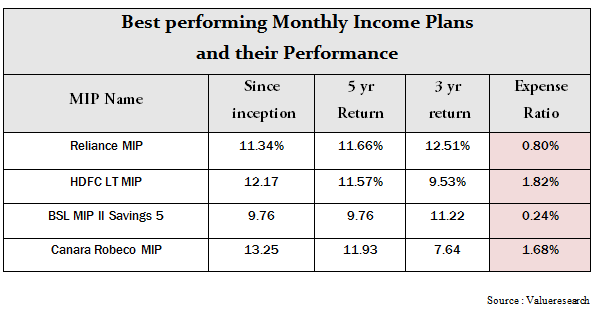 Conclusion
Conclusion
So the main takeaway from this article for you should be to understand that MIP’s can be good alternative for you if you have been investing a lot in Fixed Deposits and do not mind taking small amount of risk. Another important point was to look at MIP’s are income-generating products with understanding that sometimes the income can go for a toss in between and you have to comfortable with that.
I would love you hear your comments on monthly income plans and do you feel that it can be helpful in your portfolio , share with us !
